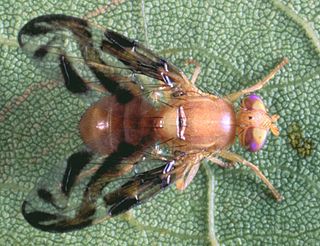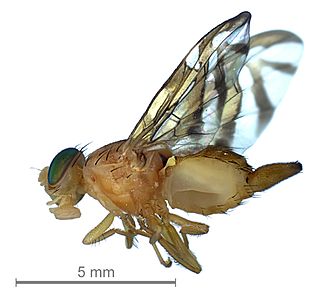
Annona is a genus of flowering plants in the pawpaw/sugar apple family, Annonaceae. It is the second largest genus in the family after Guatteria, containing approximately 166 species of mostly Neotropical and Afrotropical trees and shrubs.

The sterile insect technique (SIT) is a method of biological insect control, whereby overwhelming numbers of sterile insects are released into the wild. The released insects are preferably male, as this is more cost-effective and the females may in some situations cause damage by laying eggs in the crop, or, in the case of mosquitoes, taking blood from humans. The sterile males compete with fertile males to mate with the females. Females that mate with a sterile male produce no offspring, thus reducing the next generation's population. Sterile insects are not self-replicating and, therefore, cannot become established in the environment. Repeated release of sterile males over low population densities can further reduce and in cases of isolation eliminate pest populations, although cost-effective control with dense target populations is subjected to population suppression prior to the release of the sterile males.

The Braconidae are a family of parasitoid wasps. After the closely related Ichneumonidae, braconids make up the second-largest family in the order Hymenoptera, with about 17,000 recognized species and many thousands more undescribed. One analysis estimated a total between 30,000 and 50,000, and another provided a narrower estimate between 42,000 and 43,000 species.

The Trypetinae are a subfamily of tephritid fruit flies.

The Tephritid Workers Database is a web-based database for sharing information on tephritid fruit flies. Because these species are one of the most economically important group of insect species that threaten fruit and vegetable production and trade worldwide, a tremendous amount of information is made available each year: new technologies developed, new information on their biology and ecology; new control methods made available, new species identified, new outbreaks recorded and new operational control programmes launched. The TWD allows workers to keep up-to-date on the most recent developments and provides an easily accessible and always available resource.

Anastrepha is the most diverse genus in the American tropics and subtropics. Currently, it comprises more than 300 described species, including nine major pest species, such as the Mexican fruit fly, the South American fruit fly, the West Indian fruit fly, the sapote fruit fly, the Caribbean fruit fly, the American guava fruit fly, and the pumpkin fruit fly, as well as the papaya fruit fly. As some of their names suggest, these pest species are one of the most numerous and damaging groups of insects in their native range, plaguing commercial fruits such as citrus, mango, guava, and papaya.
Anastrepha bivittata is a species of tephritid or fruit flies in the genus Anastrepha of the family Tephritidae. The only known host plant is Gessiopermum laeve (Vell.) Miers.
Anastrepha consobrina is a species of tephritid or fruit flies in the genus Anastrepha of the family Tephritidae.
Anastrepha ethalea is a species of tephritid or fruit flies in the genus Anastrepha of the family Tephritidae.
Anastrepha hamata is a species of tephritid or fruit flies in the genus Anastrepha of the family Tephritidae.
Anastrepha integra is a species of tephritid or fruit flies in the genus Anastrepha of the family Tephritidae.
Pterocerina is a genus of picture-winged flies in the family Ulidiidae.
Pterocerina anastrepha is a species of ulidiid or picture-winged fly in the genus Pterocerina of the family Ulidiidae.

Anastrepha ludens, the Mexican fruit fly or Mexfly, is a species of fly of the Anastrepha genus in the Tephritidae family. It is closely related to the Caribbean fruit fly Anastrepha suspensa, and the papaya fruit fly Anastrepha curvicauda.

Bisabolenes are a group of closely related natural chemical compounds which are classified as sesquiterpenes. Bisabolenes are produced from farnesyl pyrophosphate (FPP) and are present in the essential oils of bisabol, and of a wide variety of other plants including cubeb, lemon, and oregano. Various derivates also function as pheromones in different insects, such as stink bugs and fruit flies. Bisabolenes are produced by several fungi, though their biological role in that group of organisms remains unclear.

Anastrepha suspensa, known as the Caribbean fruit fly, the Greater Antillean fruit fly, guava fruit fly, or the Caribfly, is a species of tephritid fruit fly. As the names suggest, these flies feed on and develop in a variety of fruits, primarily in the Caribbean. They mainly infest mature to overripe fruits. While thought to have originated in Cuba, the Caribbean fruit fly can now also be found in Florida, Hispaniola, and Puerto Rico.

Anastrepha obliqua is a species of fruit fly. It is the most important fruit fly pest of mangoes in Neotropics and attacks a wide range of other spicy fruits. A. obliqua is widespread in Mexico, Central and South America and the West Indies. It is sometimes called the West Indian fruit fly in English.
Anastrepha grandis is a fruit fly, also known as the South American cucurbit fruit fly. It is a pest of various cultivated species of Cucurbitaceae, especially the pumpkin, squash and melon. Anastrepha grandis is found in almost all South American countries.

Anastrepha fraterculus, known as the South American fruit fly, is a fruit fly species from the genus Anastrepha. A. fraterculus is a polyphagous, frugivorous fly that is a significant pest of commercial fruit production in South America.










